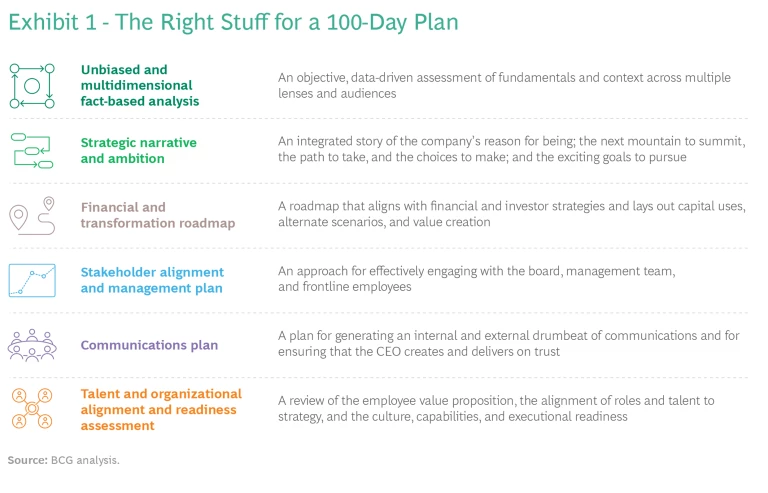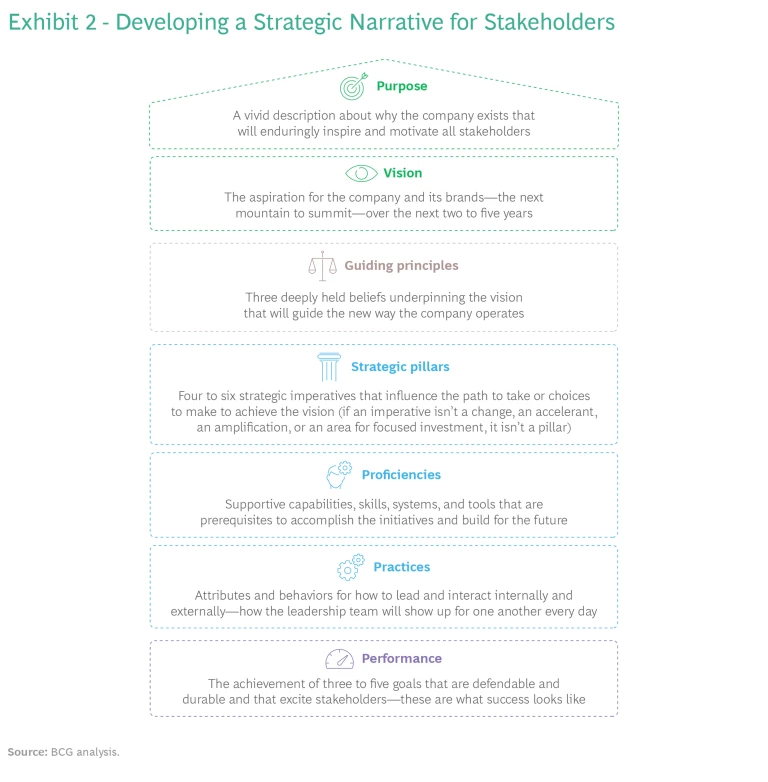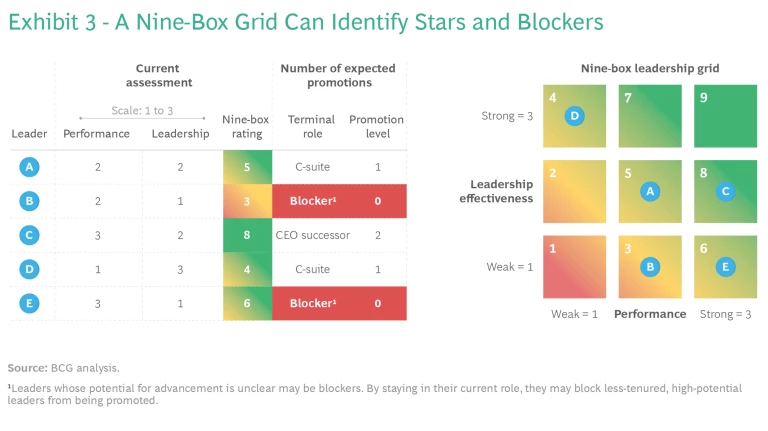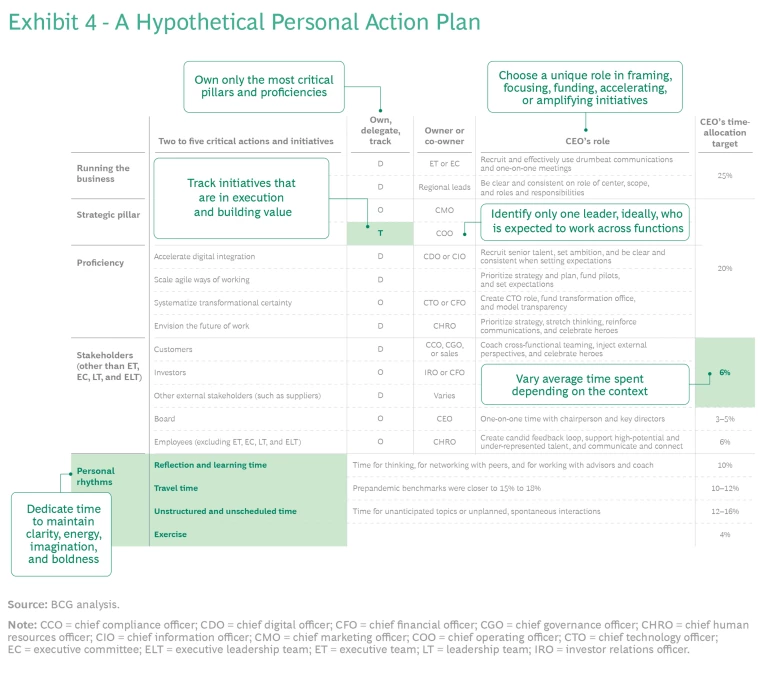When CEOs embark on their first 100 days, their calendars fill with a frenetic set of familiar activities—employee listening tours, factory visits, meetings with key customers and suppliers, and so on. These whistle-stop activities are necessary. People want to meet the new boss, in person or virtually. And the CEO wants to create a positive first impression. But emphasizing the outward-facing parts of the job risks crowding out other crucial tasks that are best undertaken early in a CEO’s tenure.
The first 100 days is a time for boldness and clarity—a time when CEOs can express the purest form of their vision for the company. They can have the least tolerance for “the way we do things around here” and the best chance to set the pace, tone, direction, and expectations. For CEOs who are hired away from another company, this is also the best chance to capitalize on their outsider’s perspective.
In their first 100 days, CEOs should create a multifaceted and integrated narrative that lays out their strategic ambition as well as their transformation, stakeholder management, communications, and talent assessment plans. Most new CEOs talk about these topics. But when it comes to where they spend their time or resources in the first 100 days, many lean into their comfort zones or leadership styles. For example, CEOs who have risen through the ranks in sales or marketing may over invest in listening tours and spend too much time on the frontline. CEOs who have come up in finance and operations often lean into financial teardowns, investor feedback, and risk assessments. Fewer balance and integrate feedback from multiple stakeholders and emerge from their first 100 days with a 360° plan to be both a great company and a great stock.
Stay ahead with BCG insights on business transformation
The first 100 days is always high stakes, but especially now. Economic, social, and political uncertainties are high, and expectations about the role of the CEO are changing. What happens during this period sets the stage for the next three to five years. Empirical studies show that transformations implemented early in a CEO’s tenure benefit from compounding effects.
The first 100 days concept can be useful at any inflection point for the business. A sharp decline in the share price, a sudden vulnerability to activist investors, or a recapitalization (such as a private-equity deal) are all opportunities for the CEO to step back and reset. The exercise applies equally well when business units or functions are in need of fresh thinking.
Paradoxically, the first 100 days is also the best time for CEOs to establish a regular time for reflection—to step off the treadmill and engage in deep thought, examining underlying assumptions, core beliefs, and knowledge. The act of reflection is the least visible part of a CEO’s job. But its value can be exponential, leading to breakthrough insights, conviction, and alignment.
The Right Stuff for the First 100 Days
With so many demands on their time and attention, it’s no wonder that CEOs can become distracted early in their tenure. By focusing on six facets, CEOs can kick off a performance-oriented launch. (See Exhibit 1.)

An Unbiased and Multidimensional Fact-Based Analysis. Leaders need an objective, data-driven assessment of business fundamentals: operational efficiency, market trends, opportunities, and the ability to fund longer-term transformation or innovation bets. The analysis of a company should provide financial breakdowns and returns by business unit, channel, product or service, and customer type. It should also assess market position, product portfolios, and the financial heft of competitors. At the end of this exercise, CEOs and CFOs should understand what drives stock price multiples in their sector and have a plan to generate value through focused actions and contingencies.
This review will also provide CEOs with a fresh, unbiased, analytic view of how their brands and businesses are viewed by investors, analysts, customers, partners, and influencers. CEOs should be clear-eyed on assets as well as points of genuine differentiation. They should know what needs their vision fulfills in the market and the world, and they should identify rivals—those that they must compete against with a vigorous defense and those that they can take share from with an astute offense.
A Strategic Narrative and Ambition. CEOs need a clear narrative to tell investors, employees, and other stakeholders about where the company is headed, how it intends to get there, and what a great company and great stock look like. (See Exhibit 2.) Their vision is tied to specific priorities, initiatives, and operational changes that will bring it to life. Equally important, CEOs need to be clear and get agreement on the paths that the company will not take. Their vision is perhaps their most visible stamp on the organization, at least in the first half of their tenure.

New CEOs who anticipate the need for a transformation should incorporate it into their strategic narrative and ambition. CEOs who recognize and initiate transformational change early tend to be more successful in delivering results. New CEOs can capitalize on their clean slate and momentum to fuel transformational change.
A Financial and Transformation Roadmap. The roadmap lays out revenue and cost projections, required investments, and anticipated improvements in operational and financial metrics over two to four years. In other words, it declares how much change investors and other stakeholders should expect and how quickly it will occur. The roadmap should be developed in parallel with the company’s financial and investor strategies to maximize value creation. To provide transparency, the roadmap has both upside and Armageddon scenarios so that stakeholders can assess likely capital allocations and cash positions and the speed and shape of value creation.
A Stakeholder Alignment and Management Plan. CEOs need an intentional plan to align internal and external stakeholders—including nongovernmental organizations (NGOs), activist shareholders, and other nontraditional stakeholders—so that each group understands the goals they share and is committed to achieving them. CEOs should also focus on how they engage with the board of directors and their management team to drive alignment and accountability throughout the organization. This work should include a rhythm of topics for the board and a set of norms, or ways of working together, for the management team. The stakeholder management plan should also address how the CEO will engage the frontline as well as receive candid feedback from deep in the organization.
CEOs should focus on how they engage with the board and management team to drive alignment throughout the organization.
A Communications Plan. Beyond the stakeholder alignment and management plan, CEOs should have an intentional approach to communicating with all critical stakeholders: large shareholders, their inner circle, senior leaders, employees, governments, analysts, the media, and NGOs. The CEO’s success often depends on productive engagement with these groups. Increasingly, customers and employees also expect CEOs to be public figures with more visibility, authentic sharing, and more caring and vulnerability than ever before.
The plan should articulate a content strategy for each group, including cadence, channels, and objectives. Intentional CEOs further view these interactions as an opportunity both to reinforce the company’s purpose and priorities and demonstrate elements of their leadership and cultural imprint.
New CEOs will not accomplish much of the foundational work that’s required or execute much of their plans in 100 or even 200 or 300 days. Strategies that address climate change and sustainability, diversity, the future of work, geopolitical uncertainty, and digital transformation will take a year or more to execute. A comprehensive communications plan will outline milestones demonstrating progress against and engagement with these initiatives.
Talent and Organizational Alignment and Readiness Assessment. CEOs need to quickly identify the strengths and weaknesses of the company’s structure, people, overall culture, and learning agenda. This review should examine the return from the company’s investment in people and their level of engagement, the company’s employee value proposition, and the alignment of the company’s top talent to deliver the vision and create value. The findings of the assessment should provide an overall understanding of the organization’s health and culture, including how it develops leaders and their level of alignment and autonomy, its success with executive teaming, how it manages performance, and its practices for helping leaders become more generative.
Within the first 100 days, CEOs should establish a management or accountability system that sets forth the cadence of weekly, monthly, quarterly, and annual decision making that they lead. They should be aligning the resources they directly control—their senior leadership teams, their calendars, and their leadership and communications platforms—with the strategic vision and value-creation priorities. During this time, CEOs should be prepared to establish new senior management roles and shuffle the management team.
Setting a Pace for the First 100 Days
The most valuable resources that CEOs have are their time and energy. CEOs cannot be constantly “on”—not even for the first 100 days. Support teams—chiefs of staff and executive assistants—can be invaluable in helping CEOs set their pace, protecting their time and managing their energy, so that they can recharge, see family and friends, and engage in activities outside of work as well as reflect and imagine at work.
Most CEOs are forced to engage in reactive thinking at the beginning of their tenure. Effective CEOs also engage in reflective thinking.
Reflective thinking—or what psychologist Daniel Kahneman calls slow thinking—is deliberate. In contrast, most CEOs are forced to engage in fast and instinctual, or reactive, thinking, particularly at the beginning of their tenure. Effective CEOs engage in both types. They use reactive thinking to solve immediate challenges and reflective thinking to clarify the big picture, achieve agreement, and imagine untapped opportunities.
New CEOs can benefit from facilitated reflection with somebody they trust who understands the demands of a CEO, the company, and the industry. While a thought partner is not essential to reflecting, such a person can help codify, constructively challenge, and synthesize thoughts and actions that emerge from focused reflection.
The Art of Structured Reflection
In our work with CEOs, several exercises have helped them with reflective thought. Here are four that are suitable for new CEOs in the first 100 days.
Develop a personal strategic narrative for the business. CEOs should construct a narrative to prioritize and sequence foundational actions that will deliver their vision and strategy over three to five years. It is a living document that many CEOs use extensively in meetings with their teams and during the strategic planning process. Ideally, this narrative is grounded in the data-driven assessment that was developed during the leader’s first 100 days. Successful CEOs also use the strategic narrative externally with shareholders and analysts.
Create a leadership imprint. This exercise asks CEOs to be mindful about how others perceive them and to be deliberate about the impression they want to convey. The effort can spark CEOs to revisit their company’s values or the executive team’s behavioral norms. CEOs can also link this exercise to their review of communications with broader internal and external audiences, such as employees, the news media, and investors.
Evaluate the top 25 to 50 leaders. This exercise complements the talent and organizational readiness assessment described earlier. A CEO assesses each senior leader on two dimensions—current performance and leadership effectiveness—using a nine-box grid. This exercise forces executives into one of the nine boxes and generates a rating for each of them. (See Exhibit 3.) The CEO also assesses how many more promotions are likely over the course of each employee’s career. The exercise helps new CEOs identify their stars—and blockers. The upper reaches of many organizations have solid executives who have reached their potential. These blockers often occupy positions that otherwise could be filled by rising stars. It also helps CEOs identify which executives to help grow by giving them high-profile assignments or by suggesting that they work with a coach, mentor, or sponsor.

Prepare a personal action plan. This plan links the priorities identified in the 100-day plan to those that the CEO wants to focus on over the first 12 months. (See Exhibit 4.) For each strategy and priority, CEOs reflect on the amount of time to allocate as well as the unique role to play: own, delegate, or track. They can then think through the best way to use their authority.

As part of this exercise, CEOs reflect on how to allocate their time by stakeholder, including the board, direct reports, the broader organization, customers, and other outside stakeholders such as shareholders and governmental and NGO officials. Their support team can then put the plan into operation by reserving time on their calendar for various audiences and activities, including reflection.
Rigorous 100-day planning requires trusted partners who will stimulate and challenge the CEO. At many companies, the chief HR officer, chief transformation officer, chief of staff, or CFO can play this role. Some CEOs, however, may find it difficult to be open with people already embedded in an organization that they are only starting to understand. They may prefer to work also with an outsider. Whatever their preference, it is critical for CEOs to develop the objective fact-driven assessment of the company, industry, and market. So long as CEOs and their team are committed to putting in the time, the work during the first 100 days will prepare the company for the next 1,000 and beyond.
BCG’s CEO Advisory supports the success of current and prospective CEOs through individual guided self-reflection and counsel as well as the convening of peer forums.




